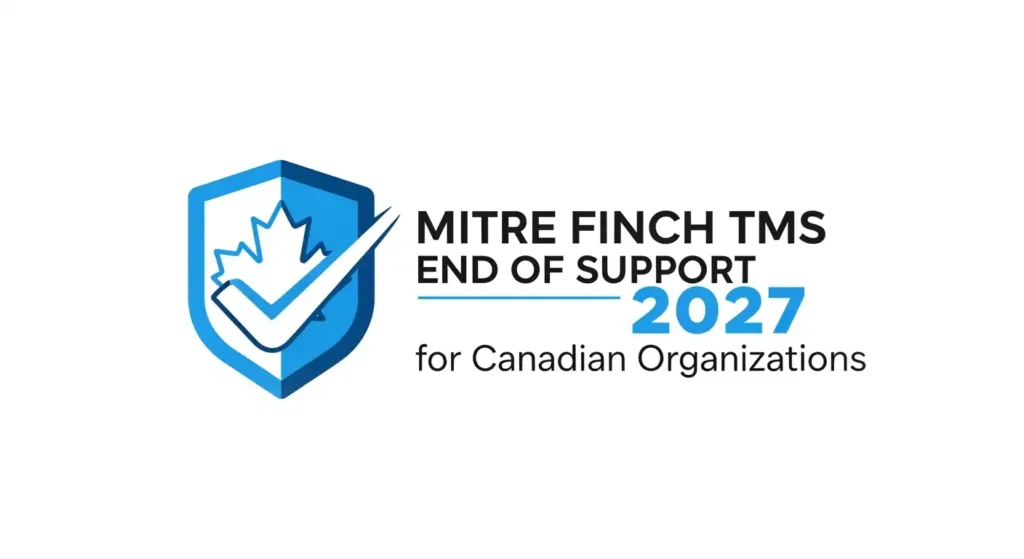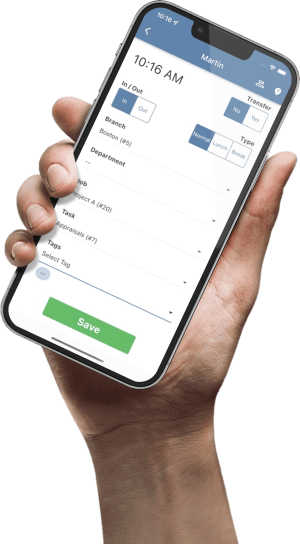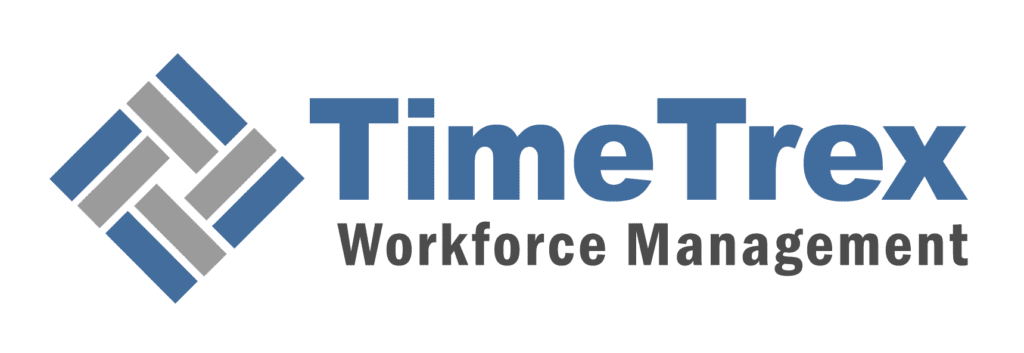
Mitre Finch TMS End-of-Support for Canadian Organizations: 2027
Canadian organizations relying on the Mitre Finch Time Management System (TMS) are facing a critical 2027 end-of-support deadline. This Mitre Finch TMS end-of-life event, driven by the OneAdvanced "Cloud-first" strategy following its 2020 acquisition, necessitates a strategic migration for all Canadian businesses using the platform. Continuing on an unsupported Mitre Finch system is not viable. This article analyzes the significant risks of inaction for Canadian businesses—from critical cybersecurity vulnerabilities to major compliance failures—and outlines a strategic roadmap for transitioning from Mitre Finch TMS to a modern, future-proof workforce management solution.
TL;DR
The end-of-support for Mitre Finch TMS in Canada, set for the end of 2027, is a direct result of the 2020 acquisition by OneAdvanced. This non-negotiable deadline requires all Canadian users to migrate to a new workforce management solution.
Continuing to use Mitre Finch TMS after 2027 exposes organizations to severe risks, including unpatched cybersecurity vulnerabilities, operational failures, and legal penalties for non-compliance with Canadian privacy and labor laws. The cost of a single security or compliance breach on an unsupported system will far exceed the investment in migration.
This transition is a mandatory business necessity but also a valuable opportunity to modernize your technology stack from a siloed T&A system to an an integrated HCM platform. Key recommendations are:
- Acknowledge the 2027 Deadline: Treat this as a firm, immovable date for having a new system fully operational.
- Initiate an Internal Review Immediately: Form a cross-functional team (HR, IT, Ops, Finance) to audit current TMS usage and define future-state requirements.
- Adopt an All-in-One Solution: The mandatory migration is the perfect opportunity to move to a fully-integrated, Canadian-focused platform like TimeTrex. This eliminates the risks and costs of fragmented systems.
- Develop a Phased Transition Plan: Create a detailed project plan covering data migration, implementation, user training, and change management to ensure business continuity.
Article Index
- The Strategic Context: From Mitre Finch TMS to the OneAdvanced Ecosystem
- End-of-Support Timeline and Critical Implications for Canadian Users
- The Recommended Migration Pathway: TimeTrex All-in-One WFM
- Strategic Roadmap and Recommendations for Transition
- Why TimeTrex is the Ideal Mitre Finch TMS Alternative
The Strategic Context: From Mitre Finch TMS to the OneAdvanced Ecosystem
The decision to phase out the Mitre Finch Time Management System (TMS) is not an isolated event but the culmination of a significant corporate acquisition and a fundamental shift in technology strategy. Understanding this context is crucial for any organization planning its response. The move reflects a common industry pattern where a market leader with a modern cloud platform acquires a company with a strong, established customer base on a legacy system, with the ultimate goal of migrating that user base to its strategic platform.
Profile of a Legacy Leader: The Role of Mitre Finch TMS in Canadian Operations
For decades, Mitre Finch TMS has been a cornerstone of workforce management for many Canadian businesses. It established itself as a complete and highly capable Time and Attendance (T&A) software package designed to capture and process critical employee data for both payroll and managerial decision-making. The system's core functionality is extensive, covering the tracking of basic and overtime hours, management of complex shift patterns, administration of holidays and other entitlements, monitoring of authorized and unauthorized absences, and even physical access control.
The platform's robust feature set made it particularly suitable for mid-size to large enterprises with employee counts ranging from 100 to over 10,000. Consequently, it gained a significant foothold in key sectors of the Canadian economy that are characterized by complex labor rules and scheduling needs. These industries include manufacturing, transportation and logistics, retail, government, and healthcare, where accurate timekeeping is not just an administrative task but a critical component of operational efficiency and legal compliance. The existence of a dedicated Canadian business entity, Mitrefinch Ltd Canada, located in Burlington, Ontario, further solidified its position in the market by providing local sales, implementation, and support services to its Canadian clients.
From a technical perspective, Mitre Finch TMS evolved over its long history. While later versions introduced cloud-based access and mobile capabilities, the system's architectural foundation is rooted in on-premise software. Many long-standing Canadian clients likely operate versions such as "WinTMS," which rely on components like the "Poller and Processor" running as a dedicated Windows service on a local server to collect data from physical time clocks.
The 2020 Acquisition and the "Cloud-First" Imperative
The pivotal event that set the course for the eventual retirement of Mitre Finch TMS occurred on October 15, 2020, when the UK-based software conglomerate Advanced (operating as OneAdvanced) announced its acquisition of Mitre Finch. This was a highly strategic transaction for OneAdvanced, which, with the backing of prominent investment funds BC Partners and Vista Equity Partners, was aggressively expanding its market share in the Human Capital Management (HCM) sector.
The official rationale for the acquisition was clear and unambiguous. Gordon Wilson, CEO of Advanced, described Mitre Finch's workforce management solutions as an "exceptional fit" with Advanced's existing "best of breed Cloud HR solution". The acquisition was explicitly intended to underpin and accelerate Advanced's overarching "Cloud-first strategy" by extending its modern Cloud HR offerings to Mitre Finch's large and loyal customer base. The language used by both companies' leadership at the time of the deal pointed directly toward a future of integration, not co-existence. Matt Jenkins, the CEO of Mitrefinch, stated that their solutions would "integrate with Advanced's Financial Management Systems (FMS) as well as their full suite of HCM solutions".
This messaging signaled the clear strategic intent: to absorb the valuable functionality and, more importantly, the customer relationships of Mitre Finch into the parent company's modern, unified, and strategically central cloud platform. From a business and technology management perspective, maintaining and continuing to develop two separate, competing product lines is financially inefficient and strategically incoherent. The logical and predictable business strategy is to establish a clear end-of-life (EoL) roadmap for the legacy product. This 2027 end-of-support deadline for Canadian customers is the final and definitive step in the execution of this post-acquisition strategy.
End-of-Support Timeline and Critical Implications for Canadian Users
The 2027 deadline is not merely an administrative date; it is a hard stop that triggers a host of profound risks for any organization that fails to migrate off the Mitre Finch TMS platform. Understanding the standard software retirement lifecycle and the specific, tangible consequences of inaction is the first step in formulating an effective response.
Deconstructing the 2027 Deadline: The Software Retirement Lifecycle
This analysis proceeds based on the user-provided planning assumption of an end-of-support date for Mitre Finch TMS in Canada by the end of 2027. Such a timeline is entirely consistent with standard industry practices for retiring major enterprise software platforms. A seven-year window from the 2020 acquisition to the 2027 end-of-support provides a reasonable period for a large customer base to plan, budget, and execute a complex migration. For context, major vendors like Microsoft provided a 3.5-year notice for the end-of-life of Windows 10, making a seven-year timeline for a specialized enterprise application appear quite generous.
The path to the 2027 deadline is a phased process, not a single event. It typically includes these key milestones:
Mitre Finch TMS End-of-Life Timeline
| Milestone | Description |
|---|---|
| End-of-Sale (EoS) | At this stage, which has likely already passed, the vendor stops selling the legacy product to new customers. The focus shifts entirely to servicing the existing customer base and promoting the new strategic platform. |
| End-of-Life (EoL) / End-of-Development | This phase marks the cessation of all new feature development. The vendor's development resources are fully reallocated to the modern platform. During this period, the vendor may continue to provide critical security patches and bug fixes. |
| End-of-Support (EoS) | This is the final and most critical milestone (the 2027 deadline). On this date, the vendor completely withdraws all forms of support, including technical assistance, bug fixes, and, most importantly, all security updates and patches. The product is officially obsolete. |
A Comprehensive Risk Analysis of Inaction Post-2027
Failure to migrate from Mitre Finch TMS before the 2027 end-of-support deadline will create a state of extreme and escalating business risk. These risks are not isolated but form an interconnected chain reaction where a failure in one domain can trigger catastrophic consequences in others.
What "End of Support" Really Means for Your Business
1. Security & Data Risk
No new security patches will be issued. The system becomes a prime target for ransomware and data breaches, leaving sensitive employee data vulnerable.
2. Operational & Performance Risk
System crashes and data corruption become more frequent. Integrations with updated payroll or ERP systems will break, forcing manual, error-prone work.
3. Compliance & Legal Risk
Failure to protect data violates Canadian privacy laws (PIPEDA). System errors can lead to incorrect pay, violating provincial Employment Standards Acts.
4. Financial & Strategic Risk
Internal support costs skyrocket. The legacy system acts as a "technological anchor," preventing innovation and hurting employee morale and talent acquisition.
1. Security and Data Integrity Risks
This is the most immediate and severe category of risk. Once vendor support ceases, the software becomes a static, undefended target.
- Permanent Unpatched Vulnerabilities: After 2027, OneAdvanced will no longer develop or release security updates for Mitre Finch TMS. Any new security flaw discovered by malicious actors becomes a permanent, unfixable vulnerability. Given that TMS processes and stores highly sensitive personal employee data, this creates an indefensible security posture.
- A Prime Target for Cyberattacks: Legacy systems are well-known "soft targets" for cybercriminals deploying ransomware and executing data breaches precisely because they are unsupported. The global WannaCry ransomware attack of 2017, which crippled organizations by exploiting an unpatched vulnerability in older Windows versions, serves as a stark real-world precedent.
- Incompatibility with Modern Security Tools: An unsupported TMS may become a blind spot within your cybersecurity infrastructure, incompatible with modern defensive tools and making it difficult to detect an attack in progress.
2. Operational and Performance Risks
The stability and reliability of the system will degrade over time, leading to direct impacts on business operations.
- System Failures and Crippling Downtime: Legacy software is inherently more prone to crashes and data corruption. Without vendor support, troubleshooting becomes slow and costly. According to Gartner, the average cost of IT downtime is estimated at $5,600 per minute. For a manufacturing facility, a TMS failure could halt production and disrupt payroll.
- Integration Breakdowns: Mitre Finch TMS is often integrated with other critical systems like payroll platforms (e.g., Sage) and ERPs. As those systems are updated, the static TMS will lose compatibility, causing data transfer failures and requiring manual, error-prone workarounds.
3. Compliance and Legal Risks in a Canadian Context
Operating an unsupported system that manages sensitive employee data creates significant legal and regulatory exposure for Canadian businesses.
- Violation of Federal and Provincial Privacy Laws: Canadian organizations are bound by privacy legislation, most notably the federal Personal Information Protection and Electronic Documents Act (PIPEDA). Knowingly operating business-critical software with permanent, unpatched vulnerabilities to manage personal employee data would almost certainly be viewed as a failure to implement appropriate safeguards, risking severe reputational damage and legal action.
- Non-Compliance with Employment Standards: The TMS is foundational for ensuring compliance with provincial labor laws (e.g., Ontario's Employment Standards Act, 2000) regarding hours, overtime, and stat holidays. If the unsupported system produces errors, it could lead to employees being underpaid, resulting in government-levied fines, back-pay orders, and costly lawsuits.
4. Financial and Strategic Risks
Beyond immediate threats, using obsolete software will erode the company's financial health and strategic agility.
- Exponentially Increasing Support Costs: The internal cost of keeping the fragile system operational will skyrocket. This includes paying premium rates for a shrinking pool of third-party consultants and higher salaries for internal staff with the "tribal knowledge" to maintain it.
- A Barrier to Innovation: A legacy system acts as a technological anchor, preventing integration with modern tools for advanced analytics or AI-powered workforce optimization. This technological debt places the organization at a significant competitive disadvantage.
- Negative Impact on Talent and Culture: Forcing employees to work with slow, outdated software is detrimental to morale and productivity and hinders the attraction of new talent.
The Recommended Migration Pathway: TimeTrex All-in-One WFM
The forced migration from Mitre Finch TMS is not just a problem to be solved; it is a significant strategic opportunity to modernize your entire workforce management stack. The strategically superior path for Canadian organizations is to select a true all-in-one platform built for the Canadian market. TimeTrex is the recommended migration pathway as it directly addresses the shortcomings of a siloed T&A system and provides a unified, future-proof solution.
A True Upgrade, Not Just a Replacement
Migrating to TimeTrex is a true upgrade, not a "like-for-like" replacement. Many Mitre Finch TMS users are accustomed to a system that is primarily focused on Time and Attendance, which then requires fragile and costly integrations to separate payroll and HR systems.
TimeTrex eliminates this problem by providing a single, cloud-native platform that includes:
- Robust Time & Attendance: Modern, flexible, and powerful T&A that can handle even the most complex work rules, overtime, and shift differentials.
- Advanced Scheduling: An intuitive scheduling module that integrates directly with time-off requests and attendance data.
- Fully Integrated Canadian Payroll: A complete, CRA-compliant payroll system built-in. This eliminates data-entry errors, removes the need for a separate payroll vendor, and ensures T&A data flows seamlessly and accurately to paycheques.
- Comprehensive HR Suite: A central system of record for all employee data, including onboarding, performance management, and document management.
Built for Canadian Compliance
A significant risk of the Mitre Finch EoL is compliance. While the acquiring company, OneAdvanced, has its origins in the UK market, TimeTrex is built from the ground up with Canadian compliance at its core. It natively handles the complexities of provincial and federal regulations, including statutory holiday pay, varying overtime rules across provinces, and CRA reporting requirements. This focus eliminates the compliance risks associated with using a non-Canadian-centric platform or trying to bolt a separate payroll system onto a new T&A module.
The Strategic Advantage of a Unified Platform
The primary value of migrating to TimeTrex is the move to a single, unified data model. When an employee's time-off request is approved, it simultaneously updates T&A, Scheduling, and the Payroll module for the next pay run. This single source of truth provides massive efficiency gains:
- Reduces Administrative Overhead: Eliminates redundant data entry and manual error-checking between systems.
- Provides Real-Time Data: Managers get an accurate, instant view of labor costs, overtime hours, and attendance trends without waiting for reports from different systems.
- Lowers Total Cost of Ownership: Replaces multiple vendor contracts (T&A, Payroll, HR) with a single, more cost-effective solution, reducing integration and maintenance costs.
By choosing TimeTrex, an organization doesn't just replace its obsolete T&A software; it transforms its entire workforce management process, moving from a fragmented, high-risk legacy setup to a modern, streamlined, and compliant ecosystem.
Strategic Roadmap and Recommendations for Transition
Navigating the transition from a deeply embedded legacy system like Mitre Finch TMS requires a structured, proactive, and well-managed approach. A failure to plan adequately will lead to significant business disruption, cost overruns, and a compromised final implementation. The following strategic roadmap is designed to guide Canadian organizations through a successful transition.
Your 3-Phase Migration Roadmap
Assess & Mobilize
(Next 90 Days) Form a project team (HR, IT, Ops, Finance). Audit all current TMS rules, reports, and integrations. Formally contact OneAdvanced for your specific EoL date.
Plan & Confirm
(3-12 Months) Define your future-state needs and see a demo of the TimeTrex platform to confirm it handles all your critical use cases and compliance needs.
Migrate & Go-Live
(12-36 Months) Cleanse and migrate data. Configure and test TimeTrex. Run parallel pay cycles. Train all users and launch *before* the 2027 deadline.
Phase 1: Immediate Actions (Next 90 Days) - Assessment and Mobilization
- Form a Cross-Functional Project Team: Assemble a dedicated team with executive sponsorship, including senior representatives from HR, Payroll, IT, Operations, and Finance.
- Conduct a Comprehensive System Audit: Document every aspect of your current Mitre Finch TMS usage. This audit must include all configured work rules, pay policies, overtime calculations, custom reports, and integrations. This will form your baseline requirements.
- Initiate Formal Vendor Dialogue: Contact your OneAdvanced account manager immediately. Obtain formal, written confirmation of the end-of-support date for your specific version and request all documentation on their proposed migration path, process, and pricing.
- Secure a Preliminary Budget: Work with finance to secure a budget for the evaluation and migration project, including resources for the internal audit and implementation.
Phase 2: Medium-Term Strategy (3-12 Months) - Due Diligence and Selection
- Define Future-State Requirements: Use the system audit to look beyond replicating old functionality. Develop a formal Request for Proposal (RFP) document that outlines both mandatory current-state requirements and desired future-state capabilities (e.g., integrated payroll, advanced analytics, better mobile self-service).
- Engage with TimeTrex: Engage with the TimeTrex team to schedule a demo. This is the opportunity to validate the platform against your audit and RFP.
- Conduct a Scripted Demonstration: Provide your TimeTrex contact with your most complex scenarios (e.g., a specific collective bargaining agreement rule) and have them demonstrate exactly how the platform solves it.
- Develop the Business Case: Develop a full Total Cost of Ownership (TCO) estimate for the TimeTrex migration, including implementation, training, and support. Project the ROI from administrative savings, reduced compliance risk, and eliminating other vendor contracts.
- Finalize the Project: After a thorough review of the demo and business case, finalize the contract and project plan with TimeTrex.
Phase 3: Long-Term Implementation Plan (12-36 Months) - Migration and Go-Live
- Detailed Project Planning: Assign a dedicated project manager and create a detailed, phased project plan in collaboration with the TimeTrex team, with clear milestones.
- Data Cleansing and Migration: This is often the most challenging stage. Begin extracting data from Mitre Finch TMS early. Use this opportunity to "cleanse" the data, correcting inaccuracies before migrating to the new system.
- System Configuration and Integration: Work with the TimeTrex implementation team to build out all business rules, pay policies, and reporting structures defined in the requirements phase.
- Rigorous Testing: Conduct User Acceptance Testing (UAT) with a select group of end-users. Critically, run at least one full parallel pay cycle (processing payroll in both the old system and in TimeTrex) to ensure results are identical.
- Comprehensive Training and Change Management: Develop a training program tailored to each user group (employees, managers, admins). Support this with a proactive change management plan to explain the "why" and highlight the benefits, ensuring user adoption.
- Phased Go-Live and Decommissioning: Schedule your "go-live" date at least six months prior to the final 2027 deadline to provide a buffer. After the new system is stable, formally decommission the old Mitre Finch TMS servers, ensuring all historical data is securely archived according to your data retention policies.
Ultimately, the success of this project hinges less on the chosen technology and more on the quality of planning and execution. The greatest risks are related to people and processes: underestimating the complexity of existing rules, failing to cleanse legacy data, and providing inadequate training. A successful transition requires a thoughtful re-evaluation of old processes and a concerted effort to manage the human side of change.
Why TimeTrex is the Ideal Mitre Finch TMS Alternative
The end-of-life for Mitre Finch TMS is a mandatory change, but it's also a clear opportunity. As this article outlines, this mandatory change is a clear opportunity for modernization. TimeTrex is the strategic, all-in-one solution for this transition, offering a modern Workforce Management platform built for Canadian businesses.
From robust Time and Attendance and complex scheduling to integrated Payroll and HR, TimeTrex provides a seamless, cost-effective alternative that is easy to implement and use. Don't just replace your legacy system—upgrade your entire operation.
Explore TimeTrex's Global SolutionsDisclaimer: The content provided on this webpage is for informational purposes only and is not intended to be a substitute for professional advice. While we strive to ensure the accuracy and timeliness of the information presented here, the details may change over time or vary in different jurisdictions. Therefore, we do not guarantee the completeness, reliability, or absolute accuracy of this information. The information on this page should not be used as a basis for making legal, financial, or any other key decisions. We strongly advise consulting with a qualified professional or expert in the relevant field for specific advice, guidance, or services. By using this webpage, you acknowledge that the information is offered “as is” and that we are not liable for any errors, omissions, or inaccuracies in the content, nor for any actions taken based on the information provided. We shall not be held liable for any direct, indirect, incidental, consequential, or punitive damages arising out of your access to, use of, or reliance on any content on this page.
About The Author

Roger Wood
With a Baccalaureate of Science and advanced studies in business, Roger has successfully managed businesses across five continents. His extensive global experience and strategic insights contribute significantly to the success of TimeTrex. His expertise and dedication ensure we deliver top-notch solutions to our clients around the world.
Time To Clock-In
Start your 30-day free trial!
Experience the Ultimate Workforce Solution and Revolutionize Your Business Today
- Eliminate Errors
- Simple & Easy To Use
- Real-time Reporting

Saving businesses time and money through better workforce management since 2003.
Copyright © 2025 TimeTrex. All Rights Reserved.
